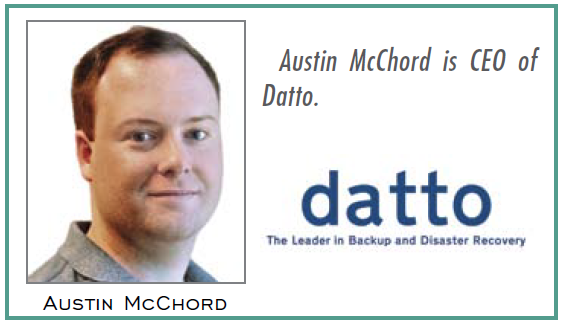Succeed With Backup And Storage In The Cloud
By Brian Albright, Business Solutions Magazine
Complexity of cloud-based solutions gives VARs and MSPs a chance to serve a consultative role.
When it comes to storage and backup and disaster recovery (BDR) solutions, the focus for most companies now is on how to leverage cloud-based, virtualized, and hosted solutions to ensure the security of their data. “There has been a major push for ‘as a service’ options, whether you are talking about hardware, software, or infrastructure,” says Austin McChord, CEO of Datto. “For MSPs that do not have a strong service infrastructure, they need to move in that direction, because that’s what vendors are going to sell them.”
 That includes pure cloud systems, as well as hybrid-cloud solutions that provide a service-based infrastructure, but with on-site hardware that can provide some measure of control and local disaster recovery and backup. “Everybody sees the cloud as inevitable,” McChord says. “You can’t get away from it. Companies are really struggling to understand and stay on top of it, because there are a thousand different directions you can go in terms of cloud services.”
That includes pure cloud systems, as well as hybrid-cloud solutions that provide a service-based infrastructure, but with on-site hardware that can provide some measure of control and local disaster recovery and backup. “Everybody sees the cloud as inevitable,” McChord says. “You can’t get away from it. Companies are really struggling to understand and stay on top of it, because there are a thousand different directions you can go in terms of cloud services.”
The decision-making process at the customer level is based on much more simple and direct factors than is often assumed, McChord says. The focus is less on technology and more on the type of support and guidance provided by vendors and resellers.
“They are making those decisions based on relationships, who they can trust, who will be there to support them,” McChord says. “Those components are a big deal for these companies.
So many things are happening so fast, that we see MSPs and VARs looking to take those customers and help them through the process. The complexity of services delivered with the cloud is incredible.”
VARs and MSPs that can help clients sort through the various cloud, hybrid, and traditional storage and backup solutions will have an edge. Customers need their help more than ever before. “There has been a radical change in this space, with so many new entrants and offerings,” McChord says.
Channel Takes Care In Partner Selection
As the number of products and potential vendor partners increases, McChord says that he has seen VARs increase their due diligence when vetting potential vendors and services. “The questions they are asking are more complex, and we’re seeing better educated MSPs out there,” McChord says. “Some of them have been burned in the past. I think that level of investigation is positive for the industry and space overall; it increases credibility. The quality of the questions we’re being asked gets better every month, and our channel partners are getting better at vetting solutions for their end customers. Everyone benefits when that happens.”
McChord identified a few emerging opportunities in the BDR space that point to potential new sources of revenue and customer touch points. One is the ability to repurpose older hardware. According to McChord, customers with an installed base of BDR hardware are looking for ways to upgrade without risking their existing investments. “The interest we’ve seen has been significant, and we expect other types of companies to move in that direction, to provide solutions that allow their customers to convert and repurpose hardware. That’s ultimately
going to save the channel money, while still keeping technology up to date,” he says.
Another large opportunity is in integrating remote monitoring and management (RMM) capabilities with BDR solutions and storage. For MSPs, this can provide real-time insight into their solutions in the field, while giving customers enhanced visibility. “People want to understand what is happening across their systems, and that is increasingly important in the managed services environment,” McChord says. “There are several tools available now that give MSPs and customers visibility into the health of their systems in real time and aid them in making smarter decisions on pricing and service delivery.”
